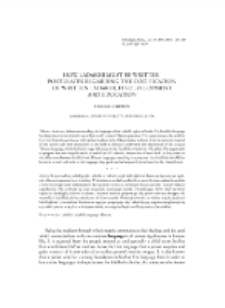
Obiekt
Tytuł: How Ladakhi Must Be Written. Postulates Regarding the Codification of Written Ladakhi, Its Development and Education
Inny tytuł:
Ethnologia Polona 37 2016 (2017)
Wydawca:
Institute of Archaeology and Ethnology Polish Academy of Sciences
Miejsce wydania:
Opis:
Typ obiektu:
Abstrakt:
This text involves a debate surrounding the language of the Ladakh region of India. The Ladakhi language has long since been written in accordance with classical Tibetan grammar. This paper stresses the need for it to be written in accordance with spoken Ladakhi style. This postulate is drawn from the personal research of the author and other researchers in the field. It does not undermine the importance of the classical Tibetan language, which has had a huge influence on the Buddhist population of Ladakh. The paper seeks to propose that the script be made accessible to all Ladakhis, irrespective of their faith. It also points to the differences between Ladakhi and Tibetan languages, resulting in a proposal that Ladakhis should first be made to read and write in the language they speak and subsequently introduced to the classical style
Bibliografia:
Butcher A. 2013. Grammatically speaking: Religious authorities and development discourse in Buddhist Ladakh, Durham Anthropology Journal 9, 95–109
Francke A. H. (1905–1941). 2000. A Lower Ladakhi Version of the Kesar Saga. With an introduction by Suniti Kumar Chatterji, Calcutta, reprint ed. Delhi
Hodge S. 1990. An Introduction to Classical Tibetan, Warminster
Khan M. T. 2014. Education in Mother Tongue – A Children’s Right. International Journal of Humanities and Management Sciences (IJHMS) 2 (4), http://www.isaet.org/images/extraimages/P1214011.pdf. Access: 03.05.2017
Koshal S. 1976. Ladakhi Phonetic Reader, CIIL Mysore
Koshal S. 1979. Ladakhi Grammar, Delhi
Naga S. T. 2012. Tibetan Language, Literature and Grammar, LTWA Dharamsala
Zeisler B. 2005. On the Position of Ladakhi and Balti in the Tibetan Language Family. In J. Bray (ed.), Ladakh Histories: Local and Regional Perspectives, Leiden–London
Zeisler B. 2006. Why Ladakhi must not be written-being part of the Great Tradition: Another kind of global thinking. In A. Saxena and L. Borin (eds), Lesser-known Languages of South Asia: Status and Policies, Case Studies and Applications of Information Technology, Berlin, 175–194
Noormohamadi R. 2008. Mother tongue, a necessary step to intellectual development, Journal of Pan-Pacific Association of Applied Linguistics 12(2), 25–36
Czasopismo/Seria/cykl:
Tom:
Strona pocz.:
Strona końc.:
Szczegółowy typ zasobu:
Format:
Identyfikator zasobu:
oai:rcin.org.pl:66277 ; 0137-4079
Źródło:
IAiE PAN, call no. P 366 ; IAiE PAN, call no. P 367 ; IAiE PAN, call no. P 368 ; kliknij tutaj, żeby przejść
Język:
Prawa:
Digitalizacja:
Institute of Archaeology and Ethnology of the Polish Academy of Sciences
Lokalizacja oryginału:
Library of the Institute of Archaeology and Ethnology of the Polish Academy of Sciences
Dostęp:
Kolekcje, do których przypisany jest obiekt:
- Repozytorium Cyfrowe Instytutów Naukowych > Kolekcje Partnerów > Instytut Archeologii i Etnologii PAN > Publikacje Pracowników i Wydawnictwa IAE PAN
- Repozytorium Cyfrowe Instytutów Naukowych > Kolekcje Partnerów > Instytut Archeologii i Etnologii PAN > Publikacje Pracowników i Wydawnictwa IAE PAN > Czasopisma bieżące
- Repozytorium Cyfrowe Instytutów Naukowych > Piśmiennictwo > Książki/Rozdziały
- Repozytorium Cyfrowe Instytutów Naukowych > Piśmiennictwo > Czasopisma/Artykuły
- Repozytorium Cyfrowe Instytutów Naukowych > Kolekcje Partnerów > Instytut Archeologii i Etnologii PAN > Publikacje Pracowników i Wydawnictwa IAE PAN > Czasopisma bieżące > Ethnologia Polona
Data ostatniej modyfikacji:
2 lut 2022
Data dodania obiektu:
26 wrz 2018
Liczba pobrań / odtworzeń:
129
Wszystkie dostępne wersje tego obiektu:
https://rcin.org.pl/publication/85954
Wyświetl opis w formacie RDF:
Wyświetl opis w formacie RDFa:
Wyświetl opis w formacie OAI-PMH:
Obiekty Podobne
Kozicz, Gerald
Galwan, Gulam Rassul (? - 1925). Autor Fohr, Paul (1869– )
Kubera, Jacek
Schwarcz, Gyöngyi

 INSTYTUT ARCHEOLOGII I ETNOLOGII POLSKIEJ AKADEMII NAUK
INSTYTUT ARCHEOLOGII I ETNOLOGII POLSKIEJ AKADEMII NAUK
 INSTYTUT BADAŃ LITERACKICH POLSKIEJ AKADEMII NAUK
INSTYTUT BADAŃ LITERACKICH POLSKIEJ AKADEMII NAUK
 INSTYTUT BADAWCZY LEŚNICTWA
INSTYTUT BADAWCZY LEŚNICTWA
 INSTYTUT BIOLOGII DOŚWIADCZALNEJ IM. MARCELEGO NENCKIEGO POLSKIEJ AKADEMII NAUK
INSTYTUT BIOLOGII DOŚWIADCZALNEJ IM. MARCELEGO NENCKIEGO POLSKIEJ AKADEMII NAUK
 INSTYTUT BIOLOGII SSAKÓW POLSKIEJ AKADEMII NAUK
INSTYTUT BIOLOGII SSAKÓW POLSKIEJ AKADEMII NAUK
 INSTYTUT CHEMII FIZYCZNEJ PAN
INSTYTUT CHEMII FIZYCZNEJ PAN
 INSTYTUT CHEMII ORGANICZNEJ PAN
INSTYTUT CHEMII ORGANICZNEJ PAN
 INSTYTUT FILOZOFII I SOCJOLOGII PAN
INSTYTUT FILOZOFII I SOCJOLOGII PAN
 INSTYTUT GEOGRAFII I PRZESTRZENNEGO ZAGOSPODAROWANIA PAN
INSTYTUT GEOGRAFII I PRZESTRZENNEGO ZAGOSPODAROWANIA PAN
 INSTYTUT HISTORII im. TADEUSZA MANTEUFFLA POLSKIEJ AKADEMII NAUK
INSTYTUT HISTORII im. TADEUSZA MANTEUFFLA POLSKIEJ AKADEMII NAUK
 INSTYTUT JĘZYKA POLSKIEGO POLSKIEJ AKADEMII NAUK
INSTYTUT JĘZYKA POLSKIEGO POLSKIEJ AKADEMII NAUK
 INSTYTUT MATEMATYCZNY PAN
INSTYTUT MATEMATYCZNY PAN
 INSTYTUT MEDYCYNY DOŚWIADCZALNEJ I KLINICZNEJ IM.MIROSŁAWA MOSSAKOWSKIEGO POLSKIEJ AKADEMII NAUK
INSTYTUT MEDYCYNY DOŚWIADCZALNEJ I KLINICZNEJ IM.MIROSŁAWA MOSSAKOWSKIEGO POLSKIEJ AKADEMII NAUK
 INSTYTUT PODSTAWOWYCH PROBLEMÓW TECHNIKI PAN
INSTYTUT PODSTAWOWYCH PROBLEMÓW TECHNIKI PAN
 INSTYTUT SLAWISTYKI PAN
INSTYTUT SLAWISTYKI PAN
 SIEĆ BADAWCZA ŁUKASIEWICZ - INSTYTUT TECHNOLOGII MATERIAŁÓW ELEKTRONICZNYCH
SIEĆ BADAWCZA ŁUKASIEWICZ - INSTYTUT TECHNOLOGII MATERIAŁÓW ELEKTRONICZNYCH
 MUZEUM I INSTYTUT ZOOLOGII POLSKIEJ AKADEMII NAUK
MUZEUM I INSTYTUT ZOOLOGII POLSKIEJ AKADEMII NAUK
 INSTYTUT BADAŃ SYSTEMOWYCH PAN
INSTYTUT BADAŃ SYSTEMOWYCH PAN
 INSTYTUT BOTANIKI IM. WŁADYSŁAWA SZAFERA POLSKIEJ AKADEMII NAUK
INSTYTUT BOTANIKI IM. WŁADYSŁAWA SZAFERA POLSKIEJ AKADEMII NAUK


































